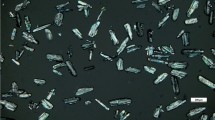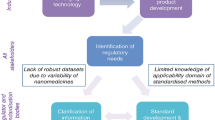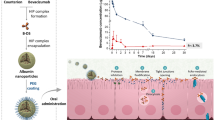ABSTRACT
Purpose
Furosemide (FURO) is a BCS class IV drug preferentially absorbed in the gastric environment. A previous study demonstrated that its intercalation into the lamellar inorganic matrix MgAl-HTlc, giving rise to MgAl-HTlc-FURO, improves its dissolution in acidic medium. As the gastric absorption of drugs can be hindered from the biological barriers mucus and gastric mucosa, the purpose of this work was to evaluate the effect of MgAl-HTlc on gastric pH, the possible modifications induced on mucus rheology and the influence on both artificial and biological membranes.
Methods
Firstly the effect of growing MgAl-HTlc concentrations on gastric pH was evaluated. Both drug flux across the mucus layer and permeability across an artificial and biological membrane (gastric mucosa) have been studied as well.
Results
The results highlighted that drug flux across gastric mucus is improved in presence of MgAl-HTlc-FURO and that MgAl-HTlc is able to modify mucus structure in a reversible manner. From permeability studies emerged that the use of a biological membrane is the most suitable for such studies and that MgAl-HTlc-FURO enhances FURO Papp.
Conclusions
Data obtained suggest that MgAl-HTlc is a suitable material able to improve the biopharmaceutical properties of class IV BCS drugs.








Similar content being viewed by others
REFERENCES
Dahan A, Miller JM, Amidon GL. Prediction of solubility and permeability class membership: provisional BCS classification of the world’s top oral drugs. AAPS J. 2009;11:740–6.
Varma MVS, Khandavilli S, Ashokraj Y, Jain A, Dhanikula A, Sood A, et al. Biopharmaceutic classification system: a scientific framework for pharmacokinetic optimization in drug research. Curr Drug Metab. 2004;5:375–88.
Lipinski C. Poor aqueous solubility—an industry wide problem in drug delivery. Am Pharm Rev. 2002;5:82–5.
Amidon GL, Lennernäs H, Shah VP, Crison JR. A theoretical basis for biopharmaceutical drug classification: the correlation of in vitro drug product dissolution and in vivo bioavailability. Pharm Res. 1995;12:413–20.
Hauss D. Oral lipid based formulations: enhancing the bioavailability of poorly water-soluble drugs. 1st ed. New York: Informa Healthcare, Marcel Dekker; 2007.
Whitehead K, Karr N, Mitragotri S. Discovery of synergistic permeation enhancers for oral drug delivery. J Control Release. 2008;128:128–33.
Ganem-Quintanar A, Kalia YN, Falson-Rieg F, Buri P. Mechanism of oral penetration enhancement. Int J Pharm. 1997;156:127–42.
Shaw LR, Irwin WJ, Grattan TJ, Conway BR. The influence of excipients on the diffusion of ibuprofen and paracetamol in gastric mucus. Int J Pharm. 2005;290:145–54.
Lamont JT. Mucus: the front line of intestinal mucosal defense. Ann N Y Acad Sci. 1992;664:190–201.
Kaunitz JD. Barrier function of gastric mucus. Keio J Med. 1999;48:63–8.
Phillipson M, Johansson MEV, Henriksnäs J, Petersson J, Gendler SJ, Sandler S, et al. The gastric mucus layers: constituents and regulation of accumulation. Am J Physiol Gastrointest Liver Physiol. 2008;295:G806–12.
Khanvilkar K, Maureen O, Donovan D, Douglas Flanagan R. Drug transfer through mucus. Adv Drug Deliv Rev. 2001;48:173–93.
Lai SK, Wang YY, Hanes J. Mucus-penetrating nanoparticles for drug and gene delivery to mucosal tissues. Adv Drug Deliv Rev. 2009;61:158–71.
Salama NN, Eddington ND, Fasano A. Tight junction modulation and its relationship to the drug delivery. Adv Drug Deliv Rev. 2006;58:15–28.
Smith J, Wood E, Donish M. Effect of chitosan on epithelial cell tight junctions. Pharm Res. 2004;21:43–9.
Aungst BJ. Intestinal permeation enhancers. J Pharm Sci. 2000;89:429–42.
Cano-Cebrián MJ, Zornoza T, Granero L, Polache A. Intestinal absorption enhancement via the paracellular route by fatty acids, chitosans and others: a target for drug delivery. Curr Drug Deliv. 2005;2:9–22.
Thanou M, Verhoef JC, Junginger HE. Chitosan and its derivatives as intestinal absorption enhancers. Adv Drug Deliv Rev. 2001;5:S91–S101.
Cornaire G, Woodley J, Hermann P, Cloarec A, Arellano C, Houin G. Impact of excipients on the absorption of P-glycoprotein substrates in vitro and in vivo. Int J Pharm. 2004;278:119–31.
Constantinides PP, Wasan KM. Lipid formulation strategies for enhancing intestinal transport and absorption of P-glycoprotein (P-gp) substrate drugs: in vitro/in vivo case studies. J Pharm Sci. 2007;96:235–48.
Goole J, Lindley DJ, Roth W, Carla SM, Amighi K, Kauffmann JM, et al. The effect of excipients on the transporter mediated absorption. Int J Pharm. 2010;393:17–31.
Del Hoyo C. Layered double hydroxides for novel biologic applications. Appl Clay Sci. 2007;36:103–21.
Choy JH, Choi SJ, Oh JH, Park T. Clay minerals and layered double hydroxides for novel biological applications. Appl Clay Sci. 2007;36:122–32.
Ambrogi V, Fardella G, Grandolini G, Perioli L. Intercalation compounds of hydrotalcite-like anionic clays with antiinflammatory agents—I. Intercalation and in vitro release of ibuprofen. Int J Pharm. 2001;220:23–32.
Choy JH, Jung JS, Oh JM, Park M, Jeong J, Kang YK, et al. Layered double hydroxide as an efficient drug reservoir for folate derivatives. Biomaterials. 2004;25:3059–64.
Ambrogi V, Perioli L, Ciarnelli V, Nocchetti M, Rossi C. Effect of gliclazide immobilization into layered double hydroxide on drug release. Eur J Pharm Biopharm. 2009;73:285–91.
del Arco M, Fernández A, Martín C, Rives V. Intercalation of mefenamic and meclofenamic acid anions in hydrotalcite-like matrixes. Appl Clay Sci. 2007;36:133–40.
Perioli L, Posati T, Nocchetti M, Bellezza F, Costantino U, Cipiciani A. Intercalation and release of antiinflammatory drug diclofenac into nanosized ZnAl hydrotalcite-like compound. Appl Clay Sci. 2011;53:374–8.
Perioli L, Ambrogi V, di Nauta L, Nocchetti M, Rossi C. Effects of hydrotalcite-like nanostructured compounds on biopharmaceutical properties and release of BCS class II drugs: The case of flurbiprofen. Appl Clay Sci. 2011;51:407–13.
Perioli L, Ambrogi V, Nocchetti M, Sisani M, Pagano C. Preformulation studies on host-guest composites for oral administration of BCS class IV: HTlc and furosemide. Appl Clay Sci. 2011;53:696–703.
Granero GE, Longhi ME, Mora MJ, Junginger HE, Midha KK, Shah VP, et al. Biowaiver monographs for immediate release solid oral dosage forms: furosemide. J Pharm Sci. 2010;99:2544–56.
Davis SS. Formulation strategies for absorption windows. Drug Discov Today. 2005;10:249–57.
Perioli L, Ambrogi V, Pagano C, Massetti E, Tiralti MC, Nocchetti M, et al. Nanostructured compounds to improve biopharmaceutical properties of drugs. 7th World Meeting on Pharmaceutics, Biopharmaceutics and Pharmaceutical Technology, Malta Valletta 8th–11th March 2010.
Corti G, Maestrelli F, Cirri M, Zerrouk N, Mura P. Development and evaluation of an in vitro method for prediction of human drug adsorption II. Demonstration of the method suitability. Eur J Pharm Sci. 2006;27:354–62.
van der Bijl P, van Eyk AD. Permeability of human intestinal mucosa using a continuous flow-through perfusion system. Int J Pharm. 2002;235:71–8.
Bhat PG, Flanagan DR, Donovan MD. The limiting role of mucus in drug absorption: drug permeation through mucus solution. Int J Pharm. 1995;126:179–87.
MacAdam A. The effect of gastrointestinal mucus on drug absorption. Adv Drug Deliv Rev. 1993;11:201–20.
Bansil R, Turner BS. Mucin structure, aggregation, physiological functions and biomedical applications. Curr Opin Colloid Interface Sci. 2006;11:164–70.
Celli J, Gregor B, Turner B, Afdhal NH, Bansil R, Erramilli S. Viscoelastic properties and dynamics of porcine gastric mucin. Biomacromolecules. 2006;6:1329–33.
Perioli L, D’Alba G, Pagano C. New oral solid dosage form for furosemide oral administration. Eur J Pharm Biopharm. 2012;80:621–9.
Khan AI, O’Hare D. Intercalation chemistry of layered double hydroxides: recent developments and applications. J Mater Chem. 2002;12:3191–8.
Jobbágy M, Regazzoni AE. Dissolution of nano-size Mg-Al-Cl hydrotalcite in aqueous media. Appl Clay Sci. 2011;51:366–9.
Maton PN, Burton ME. Antacids revisited: a review of their clinical pharmacology and recommended therapeutic use. Drug. 1999;57:855–70.
Schnaare RL, Block LH, Rohanin LC. Rheology. In: Troy DB, editor. Remington. The science and practice of pharmacy. 21st ed. Baltimore: Lippincott Williams & Wilkins; 2005. p. 350–1.
Grüber P, Bhaskar KR, Garik DR, Stanley HE, Lamont JT. Interaction of an aluminium-magnesium containing antacid and gastric mucus: possible contribution to the cytoprotective function of antacids. Aliment Pharmacol Ther. 1997;11:139–45.
Madsen F, Eberth K, Smart J. A rheological examination of the mucoadhesive/mucus interaction: the effect of mucoadhesive type and concentration. J Control Release. 1998;50:167–78.
Perioli L, Pagano C, Mazzitelli S, Rossi C, Nastruzzi C. Rheological and functional characterization of new antiinflammatory delivery system designed for buccal administration. Int J Pharm. 2008;356:19–28.
Taylor C, Allen A, Dettmar PW, Pearson JP. Two rheologically different gastric mucus secretions with different putative functions. Biochem Biophys Acta. 2004;1674:131–8.
Raynal BDE, Hardingham TE, Sheehan JK, Thornton DJ. Calcium-dependent protein interactions in MUC5B provide reversible cross-links in salivary mucus. J Biol Chem. 2003;278:28703–10.
Yee S. In vitro permeability across Caco-2 cells (colonic) can predict in vivo (small intestinal) absorption in man—fact or myth. Pharm Res. 1997;14:763–6.
Le Ferrec E, Chesne C, Artusson P, Brayden D, Fabre G, Gires P, et al. In vitro models of the intestinal barrier. ATLA. 2001;29:649–68.
Neidfors P, Ekelund M, Jeppsson B, Weström BR. Mucosal in vitro permeability in the intestinal tract of the pig, the rat, and man: species-and region-related differences. Scand J Gastroenterol. 2000;35:501–7.
ACKNOWLEDGMENTS AND DISCLOSURES
Authors are very grateful to Dr. Simonetta De Angelis and Dr. Elvio Capecci from ASL N. 1 (Città di Castello, Perugia, Italy), for providing pig samples. Special tanks are due to Mr. Marco Marani, from the Department of Chimica e Tecnologia del Farmaco, for his collaboration and technical assistance.
Author information
Authors and Affiliations
Corresponding author
Rights and permissions
About this article
Cite this article
Perioli, L., Mutascio, P. & Pagano, C. Influence of the Nanocomposite MgAl-HTlc on Gastric Absorption of Drugs: In Vitro and Ex Vivo Studies. Pharm Res 30, 156–166 (2013). https://doi.org/10.1007/s11095-012-0857-7
Received:
Accepted:
Published:
Issue Date:
DOI: https://doi.org/10.1007/s11095-012-0857-7




